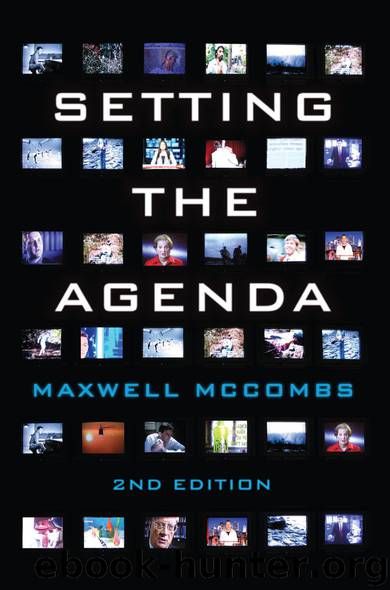Setting the Agenda: Mass Media and Public Opinion by Maxwell McCombs

Author:Maxwell McCombs
Language: eng
Format: mobi
Publisher: Wiley
Published: 2014-02-06T06:00:00+00:00
Timeframe for effects
The old hypodermic theory viewed media effects as essentially immediate. In that view, media messages were injected into the audience much as medical injections are administered to patients and typically achieve rather quick effects. Support for that perspective disappeared with the accumulation of empirical evidence in the 1940s and 1950s, a body of evidence summarized by the Law of Minimal Consequences. In response, scholars such as Wilbur Schramm asserted that the truly significant effects of mass communication were likely to be very long term, much as awesome formations of stalactites and stalagmites in caves are created drop by drop over eons of time.
Against that background, how long does it take for media attention to an issue to translate into significant salience for that issue on the public agenda? Does it really take the psychological equivalent of eons? Or could it be that the shift from attitude and opinion change to earlier points in the communication process, such as focus of attention and perceived importance, yields evidence of relatively short-term media effects?
Recall that the rise and fall of public concern about civil rights in the United States across a 23-year span of time reflected primarily the pattern of media attention to this issue in the preceding month.25 Agenda-setting effects are far from instantaneous, but they are relatively short-term. There is, of course, the question of how generalizable this picture is of the agenda-setting process. We know that the strength of agenda-setting effects can vary from issue to issue. However, two other investigations of the timeframe for agenda-setting effects also suggest that the span of time involved in the transfer of issue salience from the media agenda to the public agenda is generally in the range of four to eight weeks. A longitudinal analysis of the public opinion trends for each of three major issues during the 1960s and 1970s – pollution, drug abuse and energy – found a median correlation of +0.66 between the public agenda and the national television news agenda of the preceding month.26 A three-wave panel study found a median correlation of +0.77 between the salience of the environment among the public and the agenda of three local newspapers during the preceding two months.27 Our confidence that the public agenda typically reflects the media agenda of the preceding one to two months is enhanced by both the strength and the high degree of convergence among the correlations in all three investigations, which included both newspapers and television news and a variety of issues.
Under conditions of high personal involvement in the news, the timeframe for agenda-setting effects may be even shorter.28 Use of the internet by individuals to discuss four public issues was monitored during the 1996 US presidential election. The frequency of discussion from September until a week after the November election for immigration, health care, taxes and abortion was compared with the pattern of news coverage on these issues in the New York Times, Reuters, Associated Press, CNN and Time magazine. Discussion of immigration responded immediately to news coverage.
Download
This site does not store any files on its server. We only index and link to content provided by other sites. Please contact the content providers to delete copyright contents if any and email us, we'll remove relevant links or contents immediately.
Cecilia; Or, Memoirs of an Heiress — Volume 1 by Fanny Burney(32495)
Cecilia; Or, Memoirs of an Heiress — Volume 2 by Fanny Burney(31909)
Cecilia; Or, Memoirs of an Heiress — Volume 3 by Fanny Burney(31893)
The Great Music City by Andrea Baker(31758)
We're Going to Need More Wine by Gabrielle Union(19003)
All the Missing Girls by Megan Miranda(15779)
Pimp by Iceberg Slim(14434)
Bombshells: Glamour Girls of a Lifetime by Sullivan Steve(14022)
For the Love of Europe by Rick Steves(13590)
Talking to Strangers by Malcolm Gladwell(13290)
Norse Mythology by Gaiman Neil(13279)
Fifty Shades Freed by E L James(13187)
Mindhunter: Inside the FBI's Elite Serial Crime Unit by John E. Douglas & Mark Olshaker(9263)
Crazy Rich Asians by Kevin Kwan(9223)
The Lost Art of Listening by Michael P. Nichols(7453)
Enlightenment Now: The Case for Reason, Science, Humanism, and Progress by Steven Pinker(7273)
The Four Agreements by Don Miguel Ruiz(6701)
Bad Blood by John Carreyrou(6583)
Weapons of Math Destruction by Cathy O'Neil(6215)
